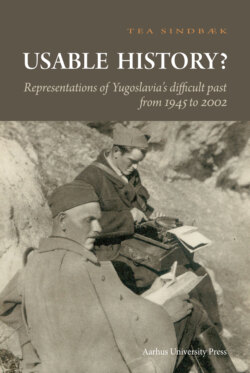Читать книгу Usable History? - Tia Sindbaek - Страница 3
На сайте Литреса книга снята с продажи.
Preface
ОглавлениеWhen in April 1941 Yugoslavia was invaded and split into pieces by Nazi- Germany and its allies, what followed was to become as much a Yugoslav civil war as a war of occupation and liberation. Groups of Yugoslavs, divided along political, ethnic and regional lines, not only fought with or against the Axis forces, but they also fought each other. During the warfare from 1941 to 1945, several hundred thousand Yugoslav civilians were killed by other Yugoslavs in large-scale massacres or concentration camps.
After the Second World War, Yugoslavia was re-established as a socialist multinational federation. The new communist regime built a large part of its self-representation and legitimacy upon the victories of the communist-led Partisans in the war. Yet the war had also left a difficult, painful and potentially divisive historical legacy to Yugoslav society; the history of these massacres could easily invoke national enmity or reawaken the political divisions of wartime Yugoslavia. In building their new ideal multiethnic state, how were the Yugoslav communists to deal with the history of massive internal Yugoslav war crimes and massacres? How would Yugoslav society and its historians represent and explain these internal massacres, and how would societal needs and political demands influence their representations?
In this book I investigate how the history of Yugoslavia’s internal Second World War massacres was presented and used in politics, historiography and popular representations of history in Yugoslavia between 1945 and 2002. The book shows how this history was drawn upon for political, ideological and other purposes, and how historical representations were influenced by political developments.
Though I frequently refer to the concept of genocide and to the massacres committed during the Second World War, this is not a book about those massacres, and it does not seek to determine whether or not the massacres committed during the war constitute genocide; this question is outside the scope of the study, and answering it would demand a completely different approach. Rather, this book is about the role of history in society; about the ways in which painful and potentially divisive history may be present in society and how such history can be drawn upon for a number of purposes.
Most of the material presented here was part of my doctoral research, which I thank the Faculty of Humanities at the University of Aarhus for financing, and my supervisors, Henning Mørk and the late Niels Kayser Nielsen for kindly overseeing. Friends and colleagues in Aarhus and elsewhere commented on parts of the manuscript, and I am very grateful to each of them. I especially want to thank Wendy Bracewell, Carol Lilly and Peter Bugge for their insightful and generous reading of the final thesis. My gratitude also goes to the Aarhus University Research Foundation and Landsdommer Gieses Legat for supporting the publication of this revised version. And finally, I thank friends and colleagues in Zagreb, Belgrade and Sarajevo, especially Petar Bagarić, Srđan Milošević, Ivo Goldstein, Dubravka Stojanović, Predrag Marković and Husnija Kamberović, who kindly illuminated me in my ignorance and patiently accepted my intrusion into a history that they know so much better than I. My hope is that I, as an outsider, may approach the subject with different presumptions and perhaps detect new patterns. All errors and mistakes remain, of course, my own.
Aarhus, August 2012
Tea Sindbæk
